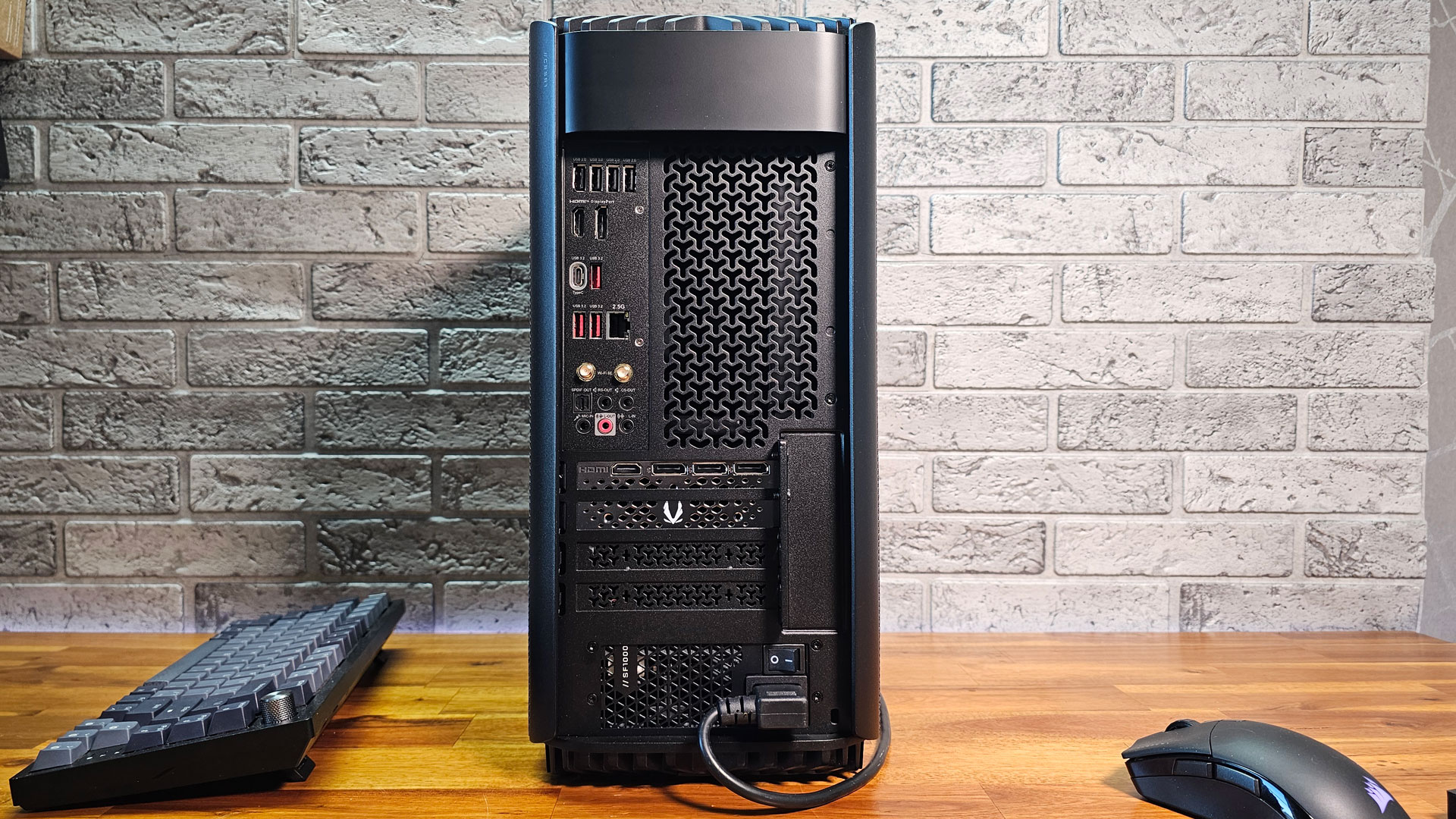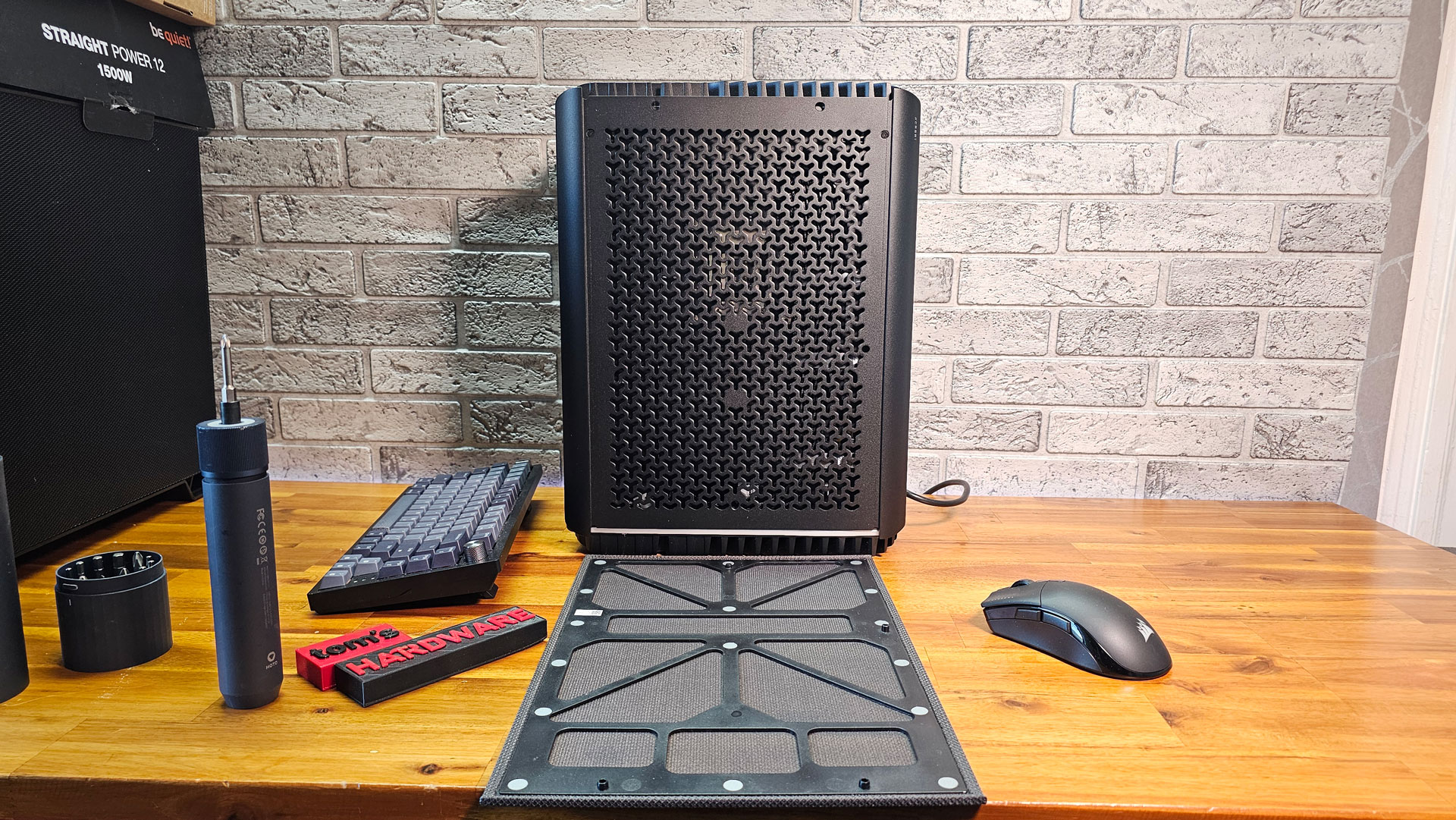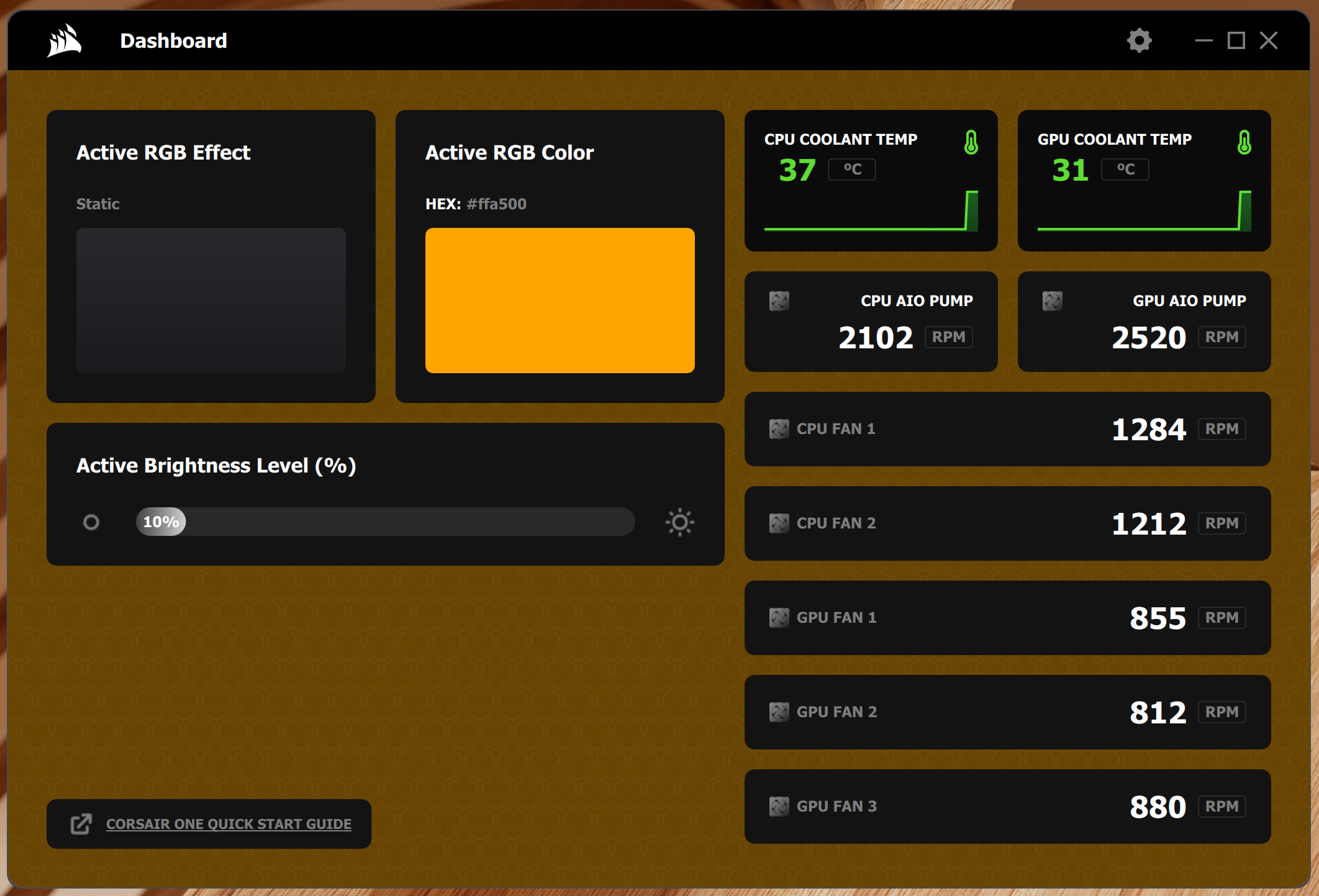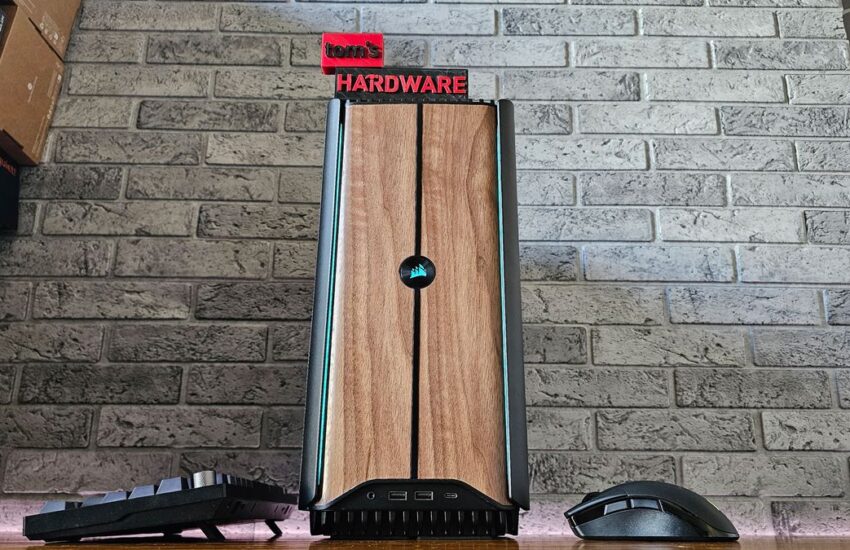It’s been two years since we last saw one of Corsair’s tiny towers, and a lot has changed in the PC industry and among the best gaming PCs. GPUs have gotten bigger (and more expensive), and on the high-end, there’s a newfound demand for premium materials in cases. The new Corsair One i500 ( $3,599.99) as tested, embraces both of those, with a larger, redesigned chassis for today’s bulky graphics cards.
And yes, that front panel is made of wood, echoing trends in the world of PC building. But all of this performance and these materials will cost you a pretty penny. But bigger also has some benefits, including a machine that’s easier to upgrade.
Design of the Corsair One i500
Well, this is different. To fit the large high-end GPUs, Corsair had to increase the footprint of the Corsair One line to something a bit closer to a small mid-tower. It should still fit on most desks, but it’s noticeably larger.
Also noticeable: Corsair has gone all-in on the wood PC cases trend. Ours came in what the company calls “wood dark,” with a dark frame and a walnut front panel but there is a lighter “wood bright” option, too with a brighter shade of aluminum and a maple panel. Corsair says each of these wooden covers should be unique, as they’re made of real wood. (At some point, the company will release versions with aluminum fronts. If you want those, you should wait, as the cases aren’t designed to have the front panels changed out.
The wood is flanked by — you guessed it — RGB light strips, which you can control with touch strips located above and below the front power button. I find the touch control to be a bit of a gimmick and much prefer to use the software. Frankly, I had a hard time remembering which parts of the touch strip did what.
The sides don’t use traditional materials, either. The filters are made of fabric. Honestly, the whole thing feels as if West Elm designed a computer. The fabric should, in theory, allow cool air to flow through the sides (more comes through the top, where the GPU radiator is mounted) and then out the opposite side and the back .
A plastic headset hanger comes with the Corsair One, which can be attached to the top on either side of the desktop. (Ours was a 3D printed prototype, so it’s hard to say exactly how the final one will feel.)
On the rear of the PC, there’s a bit more lighting. You can tap on the bulge above the motherboard ports to turn on white, rear-panel lighting. I suppose this can be useful if you’re plugging in USB accessories in the dark. If you tap again, the lights turn off. Otherwise, it shuts off by itself.
At 15.3 x 11.8 x 7.6 inches, the Corsair One i500 is no longer really console-sized. In 2022, the Corsair One i300 using the old design was 14.96 x 6.93 x 7.87 inches, so there’s a big increase in depth here.
Corsair One i500 Specifications
| Processor | Intel Core i9-14900K |
| Motherboard | MSI MAG B760M Mortar WIFI |
| Memory | 32GB Corsair Vengeance DDR5-6000 |
| Graphics | Zotac RTX 4080 Super Trinity (16GB GDDR6X, 2,550 MHz boost clock), liquid-cooled |
| Storage | 2TB Samsung MZVL22T0HBLB-00B00 PCIe NVMe SSD |
| Networking | Wi-Fi 6E, Bluetooth 5.3, 2.5G Ethernet |
| Front Ports | 2x USB 3.2 Gen 1 Type-A, USB 3.2 Gen 1 Type-C, 3.5 mm audio jack |
| Rear Ports (Motherboard) | 4x USB 3.2 Gen 1 Type-A, 3x USB 3.2 Gen 2 Type-A, USB 3.2 Gen 2×2 Type-C, HD audio ports, DisplayPort, HDMI, Ethernet |
| Video Output (GPU) | 3x DisplayPort, HDMI |
| Power Supply | Corsair 1000W SFX 80 Plus Gold |
| Cooling | 3x 120 mm intake fans, 2x 120 mm top fans, water-cooled CPU and GPU. |
| Other | Headset hanger |
| Operating System | Windows 11 Home |
| Dimensions | 15.3 x 11.8 x 7.6 inches / 391 x 300 x 185 mm |
| Price as Configured | $3,599.99 |
Ports and Upgradeability on the Corsair One i500
On the bottom of the front of the PC, Corsair has just a few ports: a pair of USB 3.2 Gen 1 Type-A ports, a USB 3.2 Gen 1 Type-C port, and 3.5 mm audio jack. That’s pretty standard, and everything else is relegated to the rear.

On the back, you’ll find another 8 USB ports (four USB 3.2 Gen 1 Type-A, three USB 3.2 Gen 2 Type-A, and a USB 3.2 Gen 2×2 Type-C), as well as Ethernet, HD audio ports, DisplayPort, HDMI, and Wi-Fi antennas. From the GPU, there are three DisplayPorts and an HDMI output.

The Corsair One i500 is more easily upgradeable than previous Corsair Ones, but it’s not as easy as typical desktops. To get in on the left side, you need to remove the fabric panel, and then remove two screws from the aluminum side panel to remove that.
With the side fully removed, you’ll see a wall of fans. Removing two more screws lets you swing the top two fans open, (including a 120 mm radiator cooling the CPU) giving you access to the RAM slots and an additional m.2 SSD slot underneath a heatsink cover. You’ll also see the AIO watercooler for the CPU and the water-cooled GPU.
That 120 mm radiator for the CPU seems small for a Core i9. I’m surprised Corsair didn’t opt for a 240 mm cooler like it did for the GPU.
The right side opens in a similar fashion, where you remove the fabric and the aluminum side with two screws. This gets you to the rear of the PC, with clean cable management that’s nice and tidy thanks to some cable ties. There’s room to mount a 2.5-inch SSD on this side, and the power cable and SATA data cable have already been hooked up for the upgrade.
This is all, largely, a big improvement over prior Ones. At least for the increased size, you get more replaceable parts. The GPU however, may pose an issue, as Corsair recommends getting in touch with customer service for help to make the switch. In a guide to reviewers, Corsair noted that upgrading the CPU, memory, and storage won’t void your warranty. It does, however, suggest “contacting Customer Support if you would like to upgrade the graphics cards in the future.”
Gaming and Graphics on the Corsair One i500
Our Corsair One i500 review unit came ready to play with a water-cooled Nvidia GeForce RTX 4080 Super from Zotac, an Intel Core i9-14900K (also using an AIO), along with 32GB of RAM and a 2TB SSD. It performed well, though it’s no surprise that RTX 4090 systems did better in 4K – the Alienware Aurora R16 (Intel Core i9-14900KF) and MSI RS infinite 13th (using a Core i9-13900KF).
I was able to play Control, still a taxing game, at 4K reliably on the Corsair One. On the high quality preset with ray tracing enabled, the game ran at between 44 and 47 frames per second during exploration, though it sometimes did dip down to around 40 fps in combat. That’s pretty stable.
On Shadow of the Tomb Raider (highest settings), the One hit 258 fps at 1080p, effectively tying it with the 4090-enabled systems. Corsair’s desktop hit 92 fps at 4K, which is behind the results from its 4090-powered competitors at higher resolutions.
Cyberpunk 2077 (ray tracing ultra) was more of a struggle. Don’t get me wrong, it was plenty playable at 98 fps at 1080p on the Corsair, but it fell behind the Alienware (118 fps). In 4K, it just hit 30 fps, which suggests on average there were some frames below 30 fps.
Where the Corsair One truly excelled was on Far Cry 6 (ultra), hitting 161 fps at 1080p and 142 at 4K, easily surpassing both 4090 systems. This is a CPU-heavy game, so it’s possible that the cooling really helped here.
We returned to a more expected pattern on Red Dead Redemption 2 (medium), with the Corsair One hitting 172 fps at 1080p and 57 fps at 4K, but falling behind the 4090-enabled machines, as expected.
On the Borderlands 3 (“badass” preset), the Corsair One was again impressive at 241 fps at 1080p and 92 fps at 4K, but the Alienware and MSI, with RTX 4090, surpassed it.
To push the system, we ran Metro Exodus on the RTX preset 15 times, which takes about half an hour. The One ran the game at an average of 177.24 fps. During the tests, the CPU’s P cores ran at an average of 5.5 GHz, while the E-cores reached 4.25 GHz, and the overall CPU package measured 72.14 degrees Celsius. The GPU ran at 2,283 MHz and measured 52.28 C.
Productivity Performance on the Corsair One i500
With an AIO-cooled Intel Core i9-14900K and 32GB of RAM on board, the Corsair One i500 is a highly capable computer when you’re not gaming. The cooling must be helping here somewhat, as there isn’t a huge difference between the processors.
On Geekbench 5, the new PC reached a single-core score of 2,294 and a multi-core score of 25,130, just surpassing both the Alienware Aurora R16 ) and MSI RS infinite 13th (Core i9-13900KF).
The One was the fastest desktop among the three on our file transfer test, copying 25GB of files at a rate of 2,095.29 MBps, just beating the Aurora (1,923.65 MBps).
It also took the lead on Handbrake, transcoding a 4K video to 1080p in 2 minutes and 4 seconds, faster than the Aurora (2:21) and MSI (2:45)
Software and Warranty on the Corsair One i500
The most notable thing about the software on the Corsair One i500 is what isn’t there. The company has opted not to use its iCue software to control the lighting on its new desktop.
“Our aim was for Corsair One to feature minimal software that seamlessly tailors your system’s illumination and offers monitoring insights for the fans and temperature readings of the liquid cooling system,” Corsair wrote in an FAQ sent to reviewers.
Instead, we get something way less bloated: Corsair One Dashboard. It lets you change the colors and effects of the RGB lighting on the front of the system, and also serves as a hub to check the temperatures and fan speeds. It’s quick and easy to use, if nothing else. If you want to see component speeds, you could always install other software of your choosing.

The only other piece of Corsair software is Corsair Diagnostic, which lets you run stress tests, see component information, and check out the load and temperature information for the CPU and GPU (it’s a bit weird that this is here but not in the Dashboard application.) There’s also quick links to Corsair support.
Otherwise, the only other bloat is in the Start menu, with links to Microsoft Store apps like Luminary Neo – AI Photo Editor, Grammarly, and Spotify.
Corsair sells the One i500 with a two-year warranty.
Corsair One i500 Configurations
There are currently two configurations of the Corsair One i500. Each one comes in two color options: “wood dark,” which we reviewed, using a dark chassis and a walnut panel; or “wood bright” with a lighter chassis and a maple wood panel.
We tested the One with an Intel Core i9-14900K, Nvidia RTX 4080 Super, 32GB of RAM and a 2TB drive, which will run you $3,599.99.
There’s a higher-end option. For an eye-watering $4,699.99, you get the same CPU and storage, but an RTX 4090, 64GB of RAM, and a bump up to Windows 11 Pro.
Corsair says that there will also be versions with aluminum front panels, but we don’t have prices or release dates for those yet.
Bottom Line
If you’re looking for an attractive, pre-built gaming PC that will fit on your desk, the Corsair One i500 is worth considering. That is, if you can afford it. Corsair is only using top-end parts here, and the $3,599.99 starting price is a lot of money for most people.
While the machine is larger than Corsair Ones of old, it still fits on a desk and is easier to upgrade, minus the GPU. I like the wooden accents, which are nice but don’t overwhelm the case. And speaking of minimalism, it doesn’t use iCue, which I consider a win because that software is pretty bloated..
Performance was strong, but Corsair could work on cooling. There’s room for a bigger radiator for the CPU, especially a 14th Gen Core i9.
But for a premium pre-built that’s big on style, the Corsair One i500 will still attract pre-built buyers, especially those who want to make a subtle statement.
MORE: Best Gaming PCs
MORE: Best PC Builds
MORE: Best Gaming Laptops


